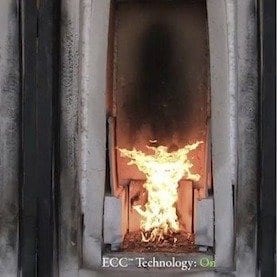
A new method for controlling fire could prevent air pollution from forming in the first place
An emerging technology could offer a more efficient way of reducing air pollution from power plants. A Seattle-based company called ClearSign Combustion has demonstrated how to manipulate flames using high-voltage electric fields to prevent pollution from forming in the first place.
Much of the air pollution produced by today’s fossil-fuel power plants is the result of imperfect combustion. Hot spots in a flame increase the reactions between fuel and air molecules and lead to formation of common air pollutants like nitrogen oxides (or NOx, a precursor to smog), carbon monoxide (CO) and particulate matter. Pollutants are commonly scrubbed after combustion and before exhaust gases are released into the atmosphere. Exhaust can be recirculated back into the combustion chamber to burn up any remaining fuel or passed through a chemical process that strips out unwanted compounds (using ammonia and a catalyst)—consuming large quantities of energy in the process. “We need energy. It’s a serious business”, says Michael Frenklach, professor of mechanical engineering at the University of California, Berkeley. “Scientists who are doing combustion research are basically trying to answer the question: How do you do it more effectively?”
Combustion can be improved by manipulating electrically charged particles (ions) in a flame to prevent hot spots—and therefore pollutants—from forming. Earlier this year, engineers at ClearSign Combustion demonstrated how a high-voltage electric field can control the shape and intensity of a flame while using only a small amount of power: less than one tenth of a percent of a furnace’s total power output.
Early test results suggest that controlling combustion with electric fields can lead to improved efficiency, compared with conventional methods. A more uniform flame shape means less fuel is wasted and exhausted as soot whereas more heat is transferred to surrounding surfaces (such as a boiler or heat exchanger for a crude oil treatment process). The biggest energy savings, however, could come from reducing or eliminating the need for conventional postcombustion pollution systems (like ammonia-based catalysts). The company claims its technology can lead to system-wide efficiency improvements up to 30 percent with comparable emissions reductions
The Latest on: Controlling combustion with electric fields
[google_news title=”” keyword=”Controlling combustion with electric fields” num_posts=”10″ blurb_length=”0″ show_thumb=”left”]
via Google News
The Latest on: Controlling combustion with electric fields
- Vision Marine Technologies Files Patent for Advanced System Communication Encryption in E-Motion Powertrainon April 29, 2024 at 3:13 pm
Vision Marine Technologies Inc. (the “Company”), a pioneer in electric propulsion innovation, is pleased to announce the patent filing for its cutting-edge Communication Cryptographic System ...
- From Self-Driving Cars to Electric Vehicles: The Latest in Automotive Innovationon April 29, 2024 at 4:53 am
Buckle up, because the automotive industry is revving up with groundbreaking innovation! From self-driving cars to electric vehicles, the future of transportation is here. Join us as we take a closer ...
- Should California’s Supreme Court overturn new rooftop solar rules?on April 26, 2024 at 11:45 am
The state's high court has agreed to hear arguments from environmental groups that oppose the changes the California Public Utilities Commission made to the net energy metering program ...
- Louisiana coal-fired power plants will face major carbon emission cuts under new EPA ruleon April 26, 2024 at 8:39 am
Louisiana's coal-fired plants are located in Lake Charles, New Roads and Lena. Emissions from coal-fired plants contribute greatly to global warming.
- TotalEnergies SE: First Quarter 2024 Resultson April 26, 2024 at 12:30 am
"Celebrating its 100 th year anniversary in 2024, TotalEnergies demonstrates once again this quarter the relevance of its balanced transition strategy that is anchored on two pill ...
- Yadea factory tour: The surprises I found at the world’s largest electric vehicle makeron April 25, 2024 at 8:28 am
Yadea now has a growing presence in Europe and has recently set its sights on a major expansion into North America. That means that Americans are set soon to get access to some of Yadea’s impressively ...
- I went to China to see the secrets of micromobility factories. Here’s what’s comingon April 24, 2024 at 9:13 am
I’ve spent many years covering just about every awesome light electric vehicle that has come out of China, from ...
- Advance through conservativeness: Audi Q4 E-Tron in a teston April 20, 2024 at 9:49 pm
A year after being tested here for the first time, the little electric brother in the Audi family arrives for another round after a facelift and renovation. Has his value proposition also changed?
- The Fastest AWD American Sedan in 2024on April 20, 2024 at 5:00 pm
A Fully Electric Future Is Projected By 2030 The 2024 CT5 is the only midsize luxury sedan from a U.S. brand that’s still available with an internal combustion engine, but that may not last long.
- How Subaru's New Ignition Technology Could Keep The Combustion Engine Aliveon April 16, 2024 at 6:00 pm
This build-up can increase fuel density and lead to the combustion process of said engine releasing more harmful hydrocarbons. Subaru sees this innovative step to pre-combustion as a way to combat ...
via Bing News









